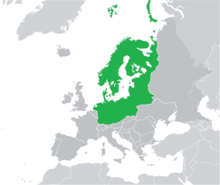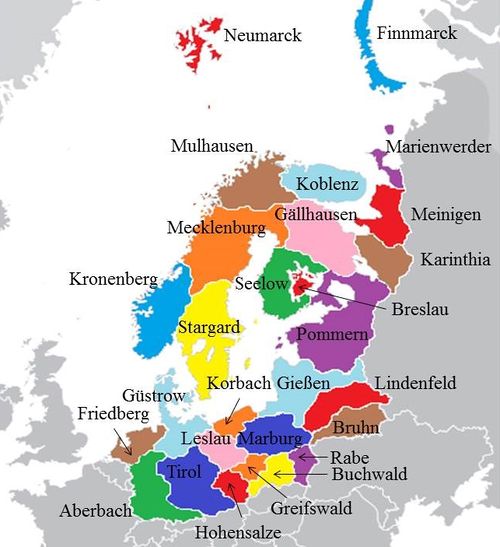Rotgeheim
| Seventh Rotgeheiman Reich Siebentes Rotgeheimes Reich
|
|||||
|---|---|---|---|---|---|
|
|||||
| Motto: "Rotgeheim siegt an allen Fronten!" "Rotgeheim is victorious on all fronts!" |
|||||
| Anthem: "Heil dir im Siegerkranz" (official) "Westerwaldlied" (popular) | |||||
Map of the Seventh Reich of Rotgeheim
|
|||||
| Region | Libertatem | ||||
| Capital | Eisenhimmel | ||||
| Largest city | Engelsscharen | ||||
| Official languages | German, English | ||||
| Recognised national languages | German | ||||
| Demonym | Rotgeheimer | ||||
| Government | Parliamentary Constitutional Monarchy | ||||
| - | Kaiser | ||||
| - | Commander-in-Chief of the Verteidigungsstaffel | ||||
| Legislature | Volksvertretung | ||||
| - | Upper house | Reichsrat | |||
| - | Lower house | Reichstag | |||
| History | |||||
| - | Settlement by refugees from Steinweg |
1801 | |||
| - | Industrialization |
1854 | |||
| - | Occupation by Steinweg | 1859 - 1887 | |||
| - | Independence | 1887 | |||
| Area | |||||
| - | Total | 34,927,504 km2 21,702,938 sq mi |
|||
| - | Water (%) | 8.3% | |||
| Population | |||||
| - | 1914 estimate | 3,979,730,000 | |||
| - | Density | 113.94/km2 295.1/sq mi |
|||
| GDP (nominal) | 1915 estimate | ||||
| - | Total | NS$730 trillion | |||
| HDI (1915) | 0.974 very high |
||||
| Currency | Rotgeheiman Reichsthaler ( RTL) (r) |
||||
| Time zone | CET (UTC +1) EET (UTC +2) |
||||
| Date format | dd ˘ mm ˘ yyyy | ||||
| Drives on the | right | ||||
| Calling code | 199 | ||||
| ISO 3166 code | RGM | ||||
| Internet TLD | .rh | ||||
The provinces (Reichsländer) of Rotgeheim
|
|||||
The Seventh Rotgeheiman Reich (German: das Siebente Rotgeheime Reich), also known as the Rotgeheiman Empire or Empire of Rotgeheim (Kaisertum Rotgeheim or Kaiserreich Rotgeheim), Seventh Reich of Rotgeheim (Siebentes Reich von Rotgeheim), or simply Rotgeheim, is a parliamentary constitutional monarchy that consists of 28 constituent provinces that occupy the whole of Northern Europe, as well as some of Western Europe, Central Europe, and Eastern Europe. The country is situated in the region of the Libertatem and spans roughly 21,702,938 square miles.
Rotgeheim was first colonized by settlers from the now-defunct nation of Steinweg after a civil war broke out between three separate belligerents forced many citizens to relocate or perish. This first group to depart Steinweg landed on the shores of the modern-day province (German: Reichsland) of Stargard in late 1801. Roughly a hundred individuals, led by an officer in the Steinweg Army named Florian Richter, arrived in Europe. After establishing a small settlement, which they had named Sparkling Coast (Funkelnde Küste), the largest vessel available (this vessel was a stolen Steinweg Navy schooner named the KM Schlupf) was ordered back with a skeleton crew to pick up more Steinwegers in need. About half a dozen trips were made back and forth between Sparkling Coast and the crumbling, war-torn Steinweg. Over five hundred refugees were saved from the civil war that engulfed the nation. After the Civil War in Steinweg ended, many citizens of the large nation fled to the new settlement in fear of the new totalitarian government. Citizens from the colony of Fuerstenburg (an Arctic territory owned by Steinweg) also fled in droves in fear of the new leader. The next seventy years saw the small settlement be built up from its lowly, humble beginnings to a large area roughly 385,000 kilometers in size, as well as the population increasing fifty fold.
Rotgeheim industrialized rapidly after 1870, with a foundation in coal, iron (and later steel), chemicals and railways. From a heavily rural nation in 1850, it was now predominantly urban in 1887. The massive numbers of immigrants arriving from nations such as Steinweg, Fuerstenburg, Schotteland, Scheinfeld, and Northern Prussia have given rise to a strong nation in science, economics, industry, and technology. The population has sharply risen from a mere hundred to over three billion in a century's time, although the numbers of immigrants in recent years have decreased dramatically.
Rotgeheim is hailed as a military superpower across the world, as its budget of NS$730 trillion allows the armed forces to stay up-to-date in the terms of equipment, as well as simply having a military that is large in numbers. The armed forces of Rotgeheim (the Verteidigungsstaffel) have never been defeated in a single engagement in its history as a fighting force. Numerous conflicts are constantly being undertaken by the armed forces, as rival nations wishing to retake lost territories from previous wars challenge Rotgeheim once more.
Contents
Etymology
The name for the territories encompassed in the Sparkling Coast settlement became known as Rotgeheim in mid 1825, although the origin of the term is still disputed. It is commonly accepted that one political leader hailing from Fuerstenburg named Eberhard Freudenthal (who arrived in 1804, among the first to flee from Fuerstenburg to Sparkling Coast) coined the term for the area after seeing aurora borealis (also known as the Northern Lights) project a red color across the night sky while on a hiking trip with fellow settlers. In his Fuerstenburger dialect he described the sight as a "Rot Geheim", or "red secret" (proper German dictates that it should correctly be called "rote Geheim", although the dialect spoken by the majority of Fuerstenburg clips off adjective endings). The capital at the time, Engelsscharen (English: "Hosts of Angels"), was mostly comprised of citizens from Fuerstenburg, and as the only printing press in the entire region was located there, all further documents regarding the nation were printed as "Rot Geheim". Eventually this was combined to read "Rotgeheim".
History
Geography
Provinces
There are 28 provinces (Reichsländer), one of which is a "free city", that make up Rotgeheim. Each province has its own constitution and is largely autonomous in regard to its internal organization. Because of differences in size among provinces, the subdivision of each province is done differently in respect to population. Citizens that descend from immigrants that originated from one of the five major places of origin (Steinweg, Fuerstenburg, Schotteland, Scheinfeld, and Northern Prussia) are classified as such. Each state is also listed with the sub classification of citizens that is in majority.
| Province | Population (2013) | Country of Origin in Majority |
|---|---|---|
| Breslau | 5,034,000 | Steinweg |
| Mecklenburg | 267,397,000 | Fuerstenburg |
| Pommern | 278,997,000 | Steinweg |
| Bruhn | 179,671,000 | Steinweg |
| Rabe | 148,994,000 | Steinweg |
| Kronenberg | 121,854,000 | Northern Prussia |
| Buchwald | 97,663,000 | Steinweg |
| Finnmarck | 23,492,000 | Fuerstenburg |
| Neumarck | 168,387,000 | Fuerstenburg |
| Greifswald | 188,132,000 | Northern Prussia |
| Stargard | 186,662,000 | Steinweg |
| Mülhausen | 82,205,000 | Steinweg |
| Gießen | 103,824,000 | Fuerstenburg |
| Koblenz | 132,020,000 | Fuerstenburg |
| Tirol | 102,057,000 | Northern Prussia |
| Gällhausen | 109,708,000 | Steinweg |
| Friedberg | 122,524,000 | Fuerstenburg |
| Meinigen | 107,114,000 | Scheinfeld |
| Aberbach | 168,228,000 | Fuerstenburg |
| Korbach | 137,222,000 | Steinweg |
| Seelow | 120,104,000 | Steinweg |
| Lindenfeld | 143,114,000 | Steinweg |
| Güstrow | 108,179,000 | Steinweg |
| Marburg | 152,119,000 | Steinweg |
| Marienwerder | 142,244,000 | Steinweg |
| Hohensalze | 93,206,000 | Fuerstenburg |
| Karinthia | 255,553,000 | Fuerstenburg |
| Leslau | 234,034,000 | Steinweg |
| Total Rotgeheim | 3,979,730,000 | Steinweg |
Demographics
Government and politics
Foreign relations
Rotgeheim strives to maintain long-lasting relationships with its neighbors. In 1912 Rotgeheim joined an alliance of nations called Libertatem, which strives to preserve individual freedoms and sovereignty of nations while at the same time banding together to halt enemy (most often communist) aggression and expansion. Although Rotgeheim cooperates with the other nations within Libertatem, minor disputes arise between Rotgeheim and a select few other countries, such as the ending of diplomatic ties to Northern Prussia in January of 1915.
Rotgeheim has been known to be very warlike in its history. Whenever heated disputes arise between an ally and another nation, Rotgeheim often teeters on the brink of invading the other nation. In the event of an ally entering a war, Rotgeheim will most likely join their ally and crush enemy opposition. A notable example of this was the 10 Days War of January 1913.
Military
Law enforcement and crime
Police force
The Reichspolizei (abbreviated as RPOL), also known as the Rotgeheim Imperial Police, is the uniformed national police force of Rotgeheim. Prior to its formation in 1888 each individual territory within Rotgeheim had its own police force, but disputes between territorial agencies necessitated the creation of a single law enforcement organization. The Imperial Police currently is allocated roughly 19% of the federal budget, allowing for the police force to sustain large numbers of both men and top of the line equipment. The Reichspolizei has millions of officers in its employment, dwarfing the police forces of the neighbors of Rotgeheim. The Orwell Orderliness Index, which ranks nations on a numerical system based on the number of law enforcement officials per citizen, ranked Rotgeheim as a 185 in 1914 - the world average is 22.
Crime
The large numbers of officers and the many ways in which suspects can be apprehended has reduced crime to near nonexistence. A study on crime in 1913 determined that crime among the youth was in nonexistence, as teenage suspects in 1913 numbered at zero. Crime is almost exclusively committed by immigrants to Rotgeheim, but even then the crime rate is significantly lower than nearly every other nation in the world. Even at its current state, the rate of crime is continually decreasing.
Economy
Infrastructure
Transportation
Throughout the years Rotgeheiman legislation has pushed to develop and maintain the many thousands of kilometers of roads, bridges, railroads, and the like in order to keep transportation simple, easy, and efficient. Rotgeheim roads have been credited with being some of the most well-kept in the world, mostly due to the large public transportation budget that covers the infrastructure of the country. Although the public transportation budget is only 1.8% of the total government expenditure, it is still several billion Rotgeheiman Reichsthalers nonetheless. A World Census study in 1914 designed to analyze the effectiveness and quality of Rotgeheiman infrastructure, which gives the nation a numerical "score", determined Rotgeheim had a mean score of 44 - this score is much higher than the world average, which is at 12.5.





